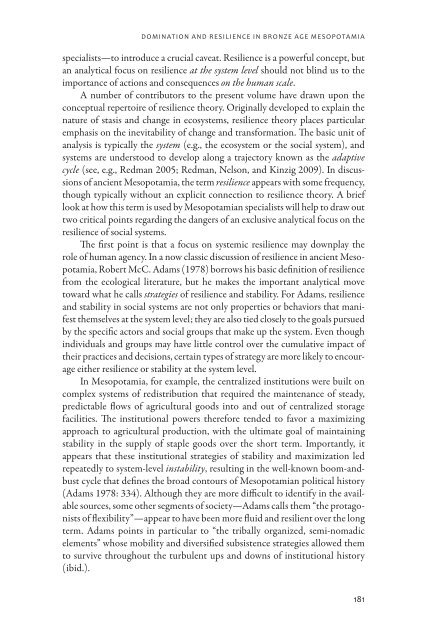free download - University Press of Colorado
free download - University Press of Colorado
free download - University Press of Colorado
You also want an ePaper? Increase the reach of your titles
YUMPU automatically turns print PDFs into web optimized ePapers that Google loves.
Domination and Resilience in Bronze Age Mesopotamia<br />
specialists—to introduce a crucial caveat. Resilience is a powerful concept, but<br />
an analytical focus on resilience at the system level should not blind us to the<br />
importance <strong>of</strong> actions and consequences on the human scale.<br />
A number <strong>of</strong> contributors to the present volume have drawn upon the<br />
conceptual repertoire <strong>of</strong> resilience theory. Originally developed to explain the<br />
nature <strong>of</strong> stasis and change in ecosystems, resilience theory places particular<br />
emphasis on the inevitability <strong>of</strong> change and transformation. The basic unit <strong>of</strong><br />
analysis is typically the system (e.g., the ecosystem or the social system), and<br />
systems are understood to develop along a trajectory known as the adaptive<br />
cycle (see, e.g., Redman 2005; Redman, Nelson, and Kinzig 2009). In discussions<br />
<strong>of</strong> ancient Mesopotamia, the term resilience appears with some frequency,<br />
though typically without an explicit connection to resilience theory. A brief<br />
look at how this term is used by Mesopotamian specialists will help to draw out<br />
two critical points regarding the dangers <strong>of</strong> an exclusive analytical focus on the<br />
resilience <strong>of</strong> social systems.<br />
The first point is that a focus on systemic resilience may downplay the<br />
role <strong>of</strong> human agency. In a now classic discussion <strong>of</strong> resilience in ancient Mesopotamia,<br />
Robert McC. Adams (1978) borrows his basic definition <strong>of</strong> resilience<br />
from the ecological literature, but he makes the important analytical move<br />
toward what he calls strategies <strong>of</strong> resilience and stability. For Adams, resilience<br />
and stability in social systems are not only properties or behaviors that manifest<br />
themselves at the system level; they are also tied closely to the goals pursued<br />
by the specific actors and social groups that make up the system. Even though<br />
individuals and groups may have little control over the cumulative impact <strong>of</strong><br />
their practices and decisions, certain types <strong>of</strong> strategy are more likely to encourage<br />
either resilience or stability at the system level.<br />
In Mesopotamia, for example, the centralized institutions were built on<br />
complex systems <strong>of</strong> redistribution that required the maintenance <strong>of</strong> steady,<br />
predictable flows <strong>of</strong> agricultural goods into and out <strong>of</strong> centralized storage<br />
facilities. The institutional powers therefore tended to favor a maximizing<br />
approach to agricultural production, with the ultimate goal <strong>of</strong> maintaining<br />
stability in the supply <strong>of</strong> staple goods over the short term. Importantly, it<br />
appears that these institutional strategies <strong>of</strong> stability and maximization led<br />
repeatedly to system-level instability, resulting in the well-known boom-andbust<br />
cycle that defines the broad contours <strong>of</strong> Mesopotamian political history<br />
(Adams 1978: 334). Although they are more difficult to identify in the available<br />
sources, some other segments <strong>of</strong> society—Adams calls them “the protagonists<br />
<strong>of</strong> flexibility”—appear to have been more fluid and resilient over the long<br />
term. Adams points in particular to “the tribally organized, semi-nomadic<br />
elements” whose mobility and diversified subsistence strategies allowed them<br />
to survive throughout the turbulent ups and downs <strong>of</strong> institutional history<br />
(ibid.).<br />
181





